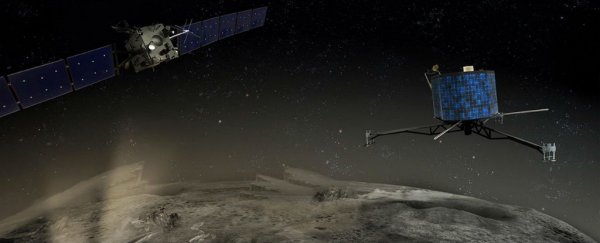Time is running out for Philae - the plucky little comet lander that stole our hearts back in 2014 - with the news that the European Space Agency's (ESA) last-ditch effort to make contact with the roving spacecraft has failed.
Philae's operators are still holding out hope that maybe they'll make a connection, but said that if they don't hear anything back from the lander by the end of January, it'll be doomed to a very grim fate - floating 300 million km away from the Sun, where frigid temperatures of around -51 degrees Celsius will render its systems inoperable. "Unfortunately, Philae's silence does not bode well," said Philae lander manager, Stephan Ulamec.
On 12 November 2014, Philae made history by being the first ever spacecraft to land successfully on the surface of a comet. The feat was nothing short of incredible - after travelling more than 6.5 billion km through space for over a decade, Philae was remotely parked by the ESA team on the surface of 67P/Churyumov-Gerasimenko, a duck-shaped comet travelling through space at 18 km per second.
The operation wasn't without its hiccups though. When it got close, Philae was supposed to shoot out harpoons to anchor it to the comet and ensure a smooth landing, but they got stuck at the last minute, and the spacecraft had to bounce its way to a landing instead. And unfortunately, where it ended up settling on the comet was too shady to properly power its solar panels, so Philae fell into a period of hibernation for seven months.
ESA finally regained contact with Philae in June last year, but the the reunion was shortlived. By 9 July 2015, it was no longer responding to commands. lander again. "It's possible that gas emissions from the comet caused Philae to shift locations again, and its antenna is pointing in a different direction," says Loren Grush at The Verge.
The Philae team has been trying to re-establish contact with Philae ever since, but hasn't heard a peep back. On 10 January, they sent what will likely be their last command to the rover via their Rosetta space probe, telling it to turn its momentum wheel on, which would maybe shift it to a better position. "At best, the spacecraft might shake dust from its solar panels and better align itself with the Sun," said Philae technical manager, Koen Geurts.
"Time is running out, so we want to explore all possibilities," added Ulamec.
It's not impossible that we could still hear back from the little lander before January is done, but we should probably start preparing for the worst. But we can be comforted in the knowledge that even if it's doomed to float alone in the frigid darkness of outer space for god knows how many years, at least Philae achieved what many of us will never get the chance to do in our lifetime: make history like an absolute champion.
